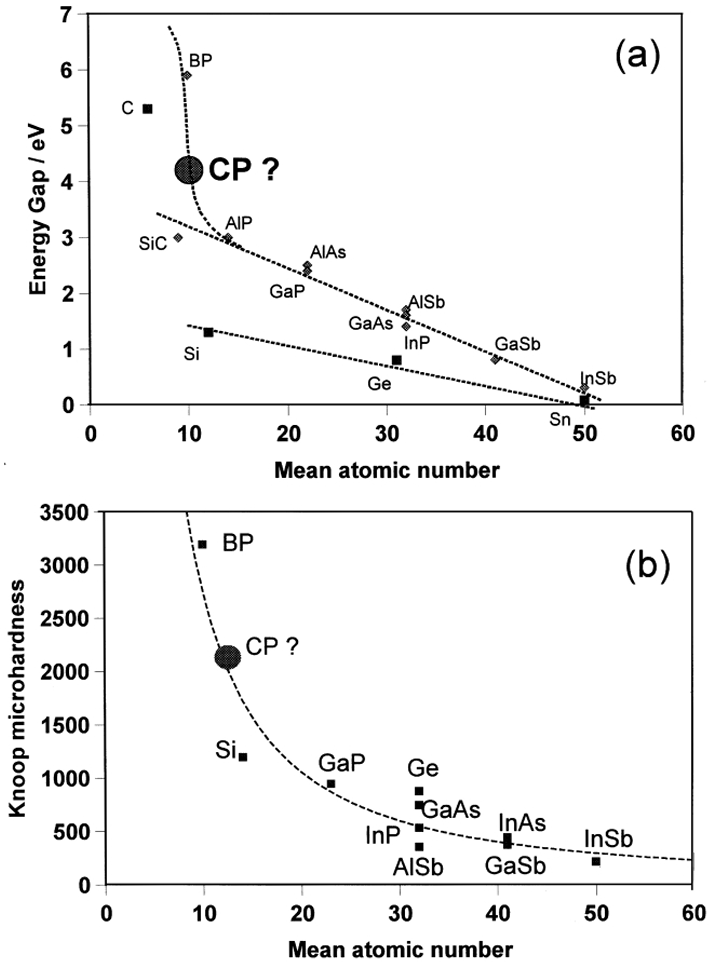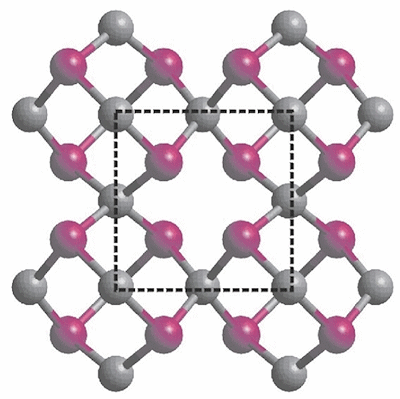 Modelling of Novel Diamond-like Materials
Modelling of Novel Diamond-like Materials
|
In collaboration with Professor Neil Allan in our Computational Chemistry section, we calculated likely stable structures for materials similar to diamond. The two we concentrated upon were carbon nitride C3N4 and carbon phosphide, a.k.a. phosphorus carbide P4C3. Calculations were carried out using planewave density functional theory (DFT) in the generalized gradient approximation (GGA) as implemented in the CASTEP code, as well as periodic numerical atomic orbitals DFT as implemented in the SIESTA code. The calculations show that at zero pressure the lowest energy structure for P4C3 is defect zinc blende, whereas for compositions richer in carbon, defect graphitic phases in which some C atoms are bonded to three P neighbours are the most stable. The predicted bulk modulus for the lowest-energy pseudocubic phase, was ~ 160 GPa. This is substantially lower than the bulk modulus of diamond (442 GPa) and that calculated for pseudocubic C3N4 (448 GPa). At the DFT level P4C3, appears to be metallic, though we caution that band gaps are commonly underestimated by DFT.
|
 The properties of various semiconductor materials and binary compounds as a function of their mean atomic number. The estimated position of a hypothetical crystalline compound of carbon phosphide (CxPy, with x=y=1) is indicated by interpolation between the data x,y points for other known binary phosphides, but this position has a degree of uncertainty depending upon the exact stoichiometry (x, y) of the material. (a) The predicted band gap for the material is between 3 and 5 eV; and (b) the Knoop hardness is predicted to be ~2000 GPa. |
To date, no-one has successfully made single-crystal phosphorus carbide, and we await these results to see how they compare to our predictions. However, we have made hard amorphous CPx films, analagous to diamondlike carbon, which have band gaps around 2 eV.
Example papers
- F. Claeyssens, N.L. Allan, P.W. May, P. Ordejon and J.P. Oliva, "Solid Phosphorus Carbide?", Chem. Comm. 21 (2002) 2494-2495.
- F. Claeyssens, J.M. Oliva, P.W. May and N.L. Allan, "Binary phosphorus-carbon compounds: the series P4C3+8n", Int. J. Quantum Chem., 95 (2003) 546-53.
- F. Claeyssens, G.M. Fuge, N.L. Allan, P.W. May, S.R.J. Pearce and M.N.R. Ashfold, "Phosphorus carbide thin films: experiment and theory", Appl. Phys. A 79 (2004) 1237-1241.
- F. Claeyssens, G.M. Fuge, N.L. Allan, P.W. May and M.N.R. Ashfold, "Phosphorus carbides: theory and experiment", Dalton Trans. (2004) 3085-3092.
- J.N. Hart, F. Claeyssens, N.L. Allan, P.W. May, "Carbon nitride: Ab initio investigation of carbon-rich phases", Phys. Rev. B 80 (2009) 174111 [doi: 10.1103/PhysRevB.80.174111].
- J.N. Hart, P.W. May, N.L. Allan, K.R. Hallam, F. Claeyssens, G.M. Fuge, M. Ruda, P.J. Heard, "Towards new binary compounds: Synthesis of amorphous phosphorus carbide by pulsed laser deposition", J. Solid State Chem. 198 (2013) 466-474. [doi: 10.1016/j.jssc.2012.11.008]

